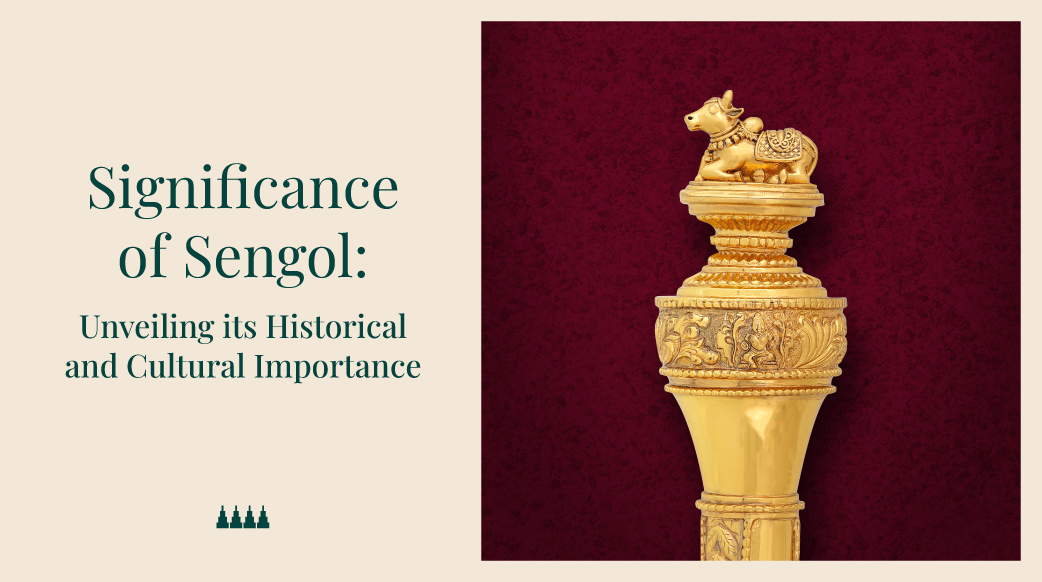The Sengol is a remarkable symbol of India’s history, culture, and struggle for independence. It represents the values of justice, good governance, and peace. So, to know more about the significance of the Sengol, read till the end of the blog.
Introduction
In a moment of great historical significance, the majestic “Sengol” now adorns the newly constructed Parliament building, symbolising the rich culture and the duty of a ruler to govern with justice and fairness.
Crafted by the esteemed Vummidi Ethiraju of the Vummidi Bangaru Chetty family, this exquisite piece made of over 100 sovereigns of gold captures the essence of power and authority. The Sengol has not only played a crucial role in India’s political landscape but also carries deep historical and cultural significance. Continue reading to know more about its significance.
Significance Of Sengol
Let’s now shed light on the Sengol’s enduring popularity and the values it embodies by exploring the historical, cultural, and other significance of Sengol.
1. Political Significance
We can witness a profound transformation that not only shapes a nation’s future but also imbues a symbol with great importance. This evolution highlights the political significance of the transfer of power and the symbolic weight accompanying it. It reminds us of the lasting legacy of a nation’s journey towards independence and self-determination.
A. The Transfer of Power:
On August 14, 1947, the Sengol was presented to India’s first Prime Minister, Pandit Jawaharlal Nehru, signifying the formal transfer of power from the British to the Indian government. This historic event marked the beginning of India’s journey as an independent nation.
B. Installation in the Parliament:
Recently, on May 28, 2023, the Sengol was installed in the Lok Sabha chamber of the new Parliament building. Prime Minister Narendra Modi performed a puja and placed the Sengol beside the Speaker’s chair. This act solidified the Sengol’s significance as a symbol of power and governance.
2. Historical Significance
History left a lasting impact, and one of its notable legacies is the Sengol. This design represented the transfer of power and was inspired by the traditional Tamil scepter. It symbolizes the orderly succession of kings and the importance of fair rule.
A. Chola Dynasty Inspiration:
The design of the Sengol is based on the traditional Tamil scepter, which was used by the mighty Chola kings. The Cholas were a prominent dynasty in the Indian subcontinent and ruled with great influence and prosperity for centuries.
B. Symbol of Power Transfer:
The Sengol signifies the transition of authority from one leader to another. In the Chola dynasty, the Sengol was used to symbolize the orderly succession of kings, emphasizing the importance of a just rule.
3. Cultural Significance
Sengol’s design carries three significant elements. The essence of India’s profound cultural heritage is revived, ensuring the vibrant display of its timeless traditions and deeply-rooted values.
A. Three Pillars of Success:
Sengol’s design features three significant elements. At the top, a statue of Nandi, a sacred animal in Hinduism, represents justice and dharma. The second layer depicts Goddess Lakshmi, the deity of wealth and prosperity. Finally, the stem showcases the image of Kodimaram, symbolising growth and fertility. Together, these elements represent the three pillars of a successful life.
B. Restoring Cultural Heritage:
The Sengol’s restoration and installation in the new Parliament building signify the importance of preserving and showcasing India’s rich cultural heritage. It serves as a reminder of the country’s ancient traditions and values.
Conclusion
The Sengol holds immense significance in both political and cultural aspects. As a symbol of power, justice, and cultural heritage, it represents the ideals that guide a nation. From its historical role in the transfer of power to its representation of Tamil culture, the Sengol stands as a timeless symbol of authority and righteousness. Its presence in the New Parliament Building serves as a constant reminder to rulers to govern with fairness and to uphold the values that have shaped India’s identity.
FAQs Related To Significance Of Sengol
What is the significance of the three elements of Sengol?
The three elements of Sengol represent the three pillars of a successful life: justice, prosperity, and growth. The statue of Nandi represents justice, the image of Lakshmi represents prosperity, and the image of Kodimaram represents growth.
What is the significance of Sengol today?
Sengol is still a significant symbol in India today. It is a reminder of the country’s history, culture, and values. It also signifies the people’s trust in the government’s governance.
What is the political significance of the Sengol?
The Sengol holds political significance as it represents the formal transfer of power from the British to the Indian government. It was presented to India’s first Prime Minister, Jawaharlal Nehru, on August 14, 1947.
Why is the restoration of the Sengol significant?
The restoration and installation of the Sengol in the new Parliament building highlight the importance of preserving and showcasing India’s rich cultural heritage. It serves as a reminder of the country’s ancient traditions and values.
Who crafted the magnificent Sengol?
The Sengol is an exquisite symbol crafted by Vummidi Ethiraju of the Vummidi Bangaru Chetty family, made of over 100 sovereigns of gold.
 Store Locator
Store Locator 









0 Comments